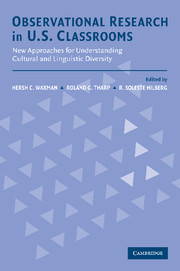 Observational Research in U.S. Classrooms
Observational Research in U.S. Classrooms Published online by Cambridge University Press: 23 November 2009
In this chapter, I test the utility of using a recently developed live observation tool, the Activity Setting Observation System (ASOS), to quantify and analyze patterns of instructional activity using a sociocultural lens. Specifically, I used the ASOS to examine the extent to which features of effective pedagogical and organizational practices were present in language arts instructional activity in 27 culturally and linguistically diverse first- and fourth-grade classrooms. In addition, I examined the association of the presence of these features with measures of student performance.
Efforts to identify best practices for culturally and linguistically diverse students from poverty backgrounds have grown steadily in recent years. Spurred by the well-known facts of underachievement among this group and its quickly increasing numbers, a number of researchers have begun to document the kinds of classroom instruction these students typically receive, as well as to investigate the kind of instruction that is effective (e.g., Brookhart & Rusnak, 1993; Estrada & Imhoff, 2001a; Garcia, 1990; Saunders & Goldenberg, 1999; Speidel, 1987; Tharp & Gallimore, 1988; Waxman, Huang, & Padrón, 1995).
Ironically, the teaching that these children receive is often an impoverished version of the common tradition dominated by whole-group instruction, teacher talk, assignment of tasks, and assessment. Studies looking at instructional practices in classrooms serving high proportions of low-income students have shown that teachers often operate with a hierarchical or linear perspective of student learning: Basic skills must be mastered before students can engage in higher-order thinking.
To save this book to your Kindle, first ensure [email protected] is added to your Approved Personal Document E-mail List under your Personal Document Settings on the Manage Your Content and Devices page of your Amazon account. Then enter the ‘name’ part of your Kindle email address below. Find out more about saving to your Kindle.
Note you can select to save to either the @free.kindle.com or @kindle.com variations. ‘@free.kindle.com’ emails are free but can only be saved to your device when it is connected to wi-fi. ‘@kindle.com’ emails can be delivered even when you are not connected to wi-fi, but note that service fees apply.
Find out more about the Kindle Personal Document Service.
To save content items to your account, please confirm that you agree to abide by our usage policies. If this is the first time you use this feature, you will be asked to authorise Cambridge Core to connect with your account. Find out more about saving content to Dropbox.
To save content items to your account, please confirm that you agree to abide by our usage policies. If this is the first time you use this feature, you will be asked to authorise Cambridge Core to connect with your account. Find out more about saving content to Google Drive.